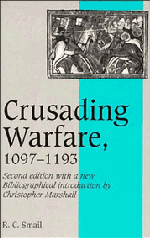Book contents
- Frontmatter
- Contents
- List of plates
- List of maps
- List of plans
- Preface (1954)
- List of abbreviations
- Bibliographical introduction (1994)
- I The historians of crusading warfare
- II Warfare and policy in Latin Syria
- III Franks, Armenians, and Syrians
- IV The Muslim armies
- V The Latin armies
- VI The Latin field army in action
- VII The Crusaders' castles
- Bibliography
- Bibliography to the second edition
- Index
- Plate section
VI - The Latin field army in action
Published online by Cambridge University Press: 29 September 2009
- Frontmatter
- Contents
- List of plates
- List of maps
- List of plans
- Preface (1954)
- List of abbreviations
- Bibliographical introduction (1994)
- I The historians of crusading warfare
- II Warfare and policy in Latin Syria
- III Franks, Armenians, and Syrians
- IV The Muslim armies
- V The Latin armies
- VI The Latin field army in action
- VII The Crusaders' castles
- Bibliography
- Bibliography to the second edition
- Index
- Plate section
Summary
THE BACKGROUND OF WARFARE
Of all men', said Usamah, ‘the Franks are the most cautious in warfare.’ At first sight this is a surprising judgement on a people renowned for their reckless fury in battle, yet the words were written by one who had often fought against the Franks in Syria, and who had reflected much on his experiences. The matters discussed in the foregoing chapters do something to explain his dictum. In Syria the Franks encountered military problems, both strategic and tactical, which imposed caution and restraint.
They fought only for limited objectives. Settled as they were on the fringe of Muslim Asia, they could never hope to overwhelm the whole strength of Islam. Originally they came to conquer certain territories which had for them unique religious associations, and they stayed to defend these conquests against counter-attack. Conquests and settlement involved domination of the land and its inhabitants, and to be continuously effective such domination needed to be based on castles and walled towns. The acquisition or successful defence of strong places was the highest prize of warfare, beside which success in battle was of secondary importance. Victory in the field, as the events of the First Crusade and the early years of the settlement showed, could help an invader, but mainly because destruction of the opposing army left him free to develop an uninterrupted attack on the fortresses.
- Type
- Chapter
- Information
- Crusading Warfare, 1097–1193 , pp. 138 - 203Publisher: Cambridge University PressPrint publication year: 1994

